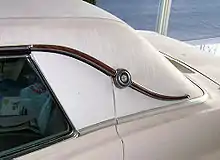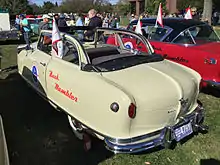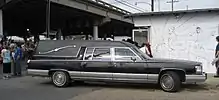Landau (automobile)
Landau is a carriage design with a folding fabric top consisting of two sections supported by elliptical springs.
When used in referencing an automobile, landau generally means a simulated convertible.[1]
The Nash Rambler Landau is a cabrio coach introduced in 1950.
A landau bar is an ornamental feature located on a car's rear quarter panel, mostly used on hearses.
Origins

Carriages that had a fabric top that could be lowered and raised were named "Landau" carriages after the city of Landau in Germany where convertible carriages were first produced.[2]
Thus the name "landau", like many other automobile terms, originates from coachbuilding (since coachbuilders began making motor car bodies instead, and because customers were familiar with coachbuilding terms).[3]
The "landau" described a carriage that featured a manually folding fabric roof that was supported by elliptical springs.[4] The top was designed with separate folding front and rear sections that raised or lowered independently or locked together in the middle to cover the carriage.[4] To differentiate the landau models, the coachbuilders typically included large sidebars.[4]
The automotive equivalent to the horse-drawn landau carriage was not popular, since a forward view was generally insisted upon by passengers. Instead, the more popular body style for automobiles was the landaulet (half-landau), with its covered front seats and open rear seats.
The 1935 handbook of the Society of Automotive Engineers defines the landau as "a closed-type body with provision for opening or folding the rear quarter, by the use of landau joints".[5]
Simulated convertible
.jpg.webp)

In the 1920s and 1930s, especially in the United States, "landau" became associated with cars where the fixed (eg metal) roof and rear quarter panels were covered with fabric or leather and fitted with S-shaped side landau bars, to make it appear like a convertible roof.[6][7]
Following the 1920s and 1930s, when custom-built bodies were available with a split front and rear roof design, the use of landau changed from a functional feature on limited production cars to that of a decorative feature in some higher market segment production cars.[8]
The term landau fell into disuse from the mid-1940s until the late-1950s.[9] It was used to describe fixed-roof cars styled to simulate a two-piece roof or to resemble convertibles, sometimes time using vinyl roofs. An example of a two-piece roof is the 1957 Imperial four-door hardtop with simulated "landau-type" roof design[10] Some models were called "landaus" by their manufacturers, and many were fitted with landau bars on the rear quarters (faux cabriolet).[7]
The "Town Landau" model was a version of the 1967 Ford Thunderbird line.[11] This included meant a wider rear C-pillar with no rear quarter windows, or a partial vinyl roof that was applied only over the rear seat area (and is thus reminiscent of a town car).
Nash Rambler Landau

In 1950, Nash Motors introduced the Rambler Landau model, which used a cabrio coach body style.[12]
This model was described as a "convertible landau"[13] and the roof section from the top of the windscreen could be retracted into the trunk/boot. As per other convertible coupes, a "bridge beam" steel structure remained in place at the top of the doors and windows.[14] The Rambler's strong body structure eliminated the internal bracing that was normally needed on other open cars.[13]
Landau bar

A landau bar is an ornamental S-shaped metallic bar installed on the rear quarter panel of a car. Mostly used on hearses, the landau bar represents the folding roof structure on a Landau carriage.[15][16]
Since the mid-1940s, landau bars have been commonly used on hearses in the United States[17] and the Philippines.
References
- Demuro, Doug (28 November 2016). "Remember the Landau Roof?". Autotrader. Retrieved 26 October 2020.
- Upton, Chad (22 November 2010). "Why Some Cars Have Fake Convertible Roofs". Broken Secrets. Retrieved 26 October 2020.
- Haajanen, Lennart W. (2003). Illustrated dictionary of automobile body styles. Jefferson, N.C.: McFarland. ISBN 9780786412761.
- Muaddi, Nadeem (12 January 2014). "Why Do We Call It a 'Landau Top'?". The Hog Ring. Retrieved 26 October 2020.
- S.A.E. Handbook. Society of Automotive Engineers. 1935. p. 730. Retrieved 3 April 2014.
- Locke, William S. (2007). Elcar and Pratt automobiles: the complete history. Mcfarland. p. 87. ISBN 9780786432547. Retrieved 3 April 2014.
- The Merriam-Webster new book of word histories. Merriam-Webster. 1991. p. 359. ISBN 9780877796039. Retrieved 3 April 2014.
Landau used on automobiles 1920s mostly advertising device to indicate a fixed roof without a rear quarter window.
- "Glossary A-Z (landau top)". haartz.com. Retrieved 26 October 2020.
- "1957 New Car parade: Chrysler family makes debut". Popular Mechanics. 106 (5): 104. November 1956. Retrieved 3 April 2014.
- "1957 Imperial foldout". oldcarbrochures.com. p. 5. Retrieved 26 October 2020.
- Gunnell, John (25 October 2005). American Cars of the 1960s: A Decade of Diversity. Krause Publications. p. 87. ISBN 9780896891319. Retrieved 3 April 2014.
- Flory, Jr., J. Kelly (2008). American Cars, 1946-1959: Every Model, Year by Year. McFarland. pp. 295–298. ISBN 9780786452309. Retrieved 3 April 2014.
- "Rambler". Automobile Quarterly. 33 (2): 33. 1994.
- Gunnel, John (2004). Standard Guide to 1950s American Cars. Krause Publications. pp. 162–163. ISBN 9780873498685. Retrieved 3 April 2014.
- "Why Do Hearses Have Metal S-Shaped Scrolls Where the Back Windows Should Be?". www.mentalfloss.com. Retrieved 14 June 2018.
- "Landau Bars On Hearses Are So Very Stupid". www.jalopnik.com. Retrieved 14 June 2018.
- Schechter, Harold (2009). The Whole Death Catalog: A Lively Guide to the Bitter End. Ballantine Books. p. 119. ISBN 9780345512512. Retrieved 3 April 2014.